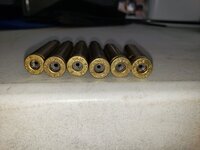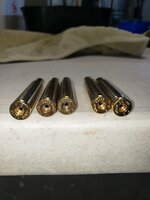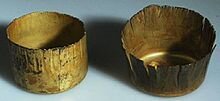- Messages
- 2,633
- Reactions
- 4,004
I have played with a lot of combos for brass amounts, soaps, waxes etc. and have found this to be the best for me.
I use a FA tumbler with the 5 pounds of pins provided with the kit. I add 10 pounds of brass and fill with water to the neck. These brings the load up to 28 pounds, which is nicely just below the 30 pound recommenced maximum weight. (By the way, fill with water first then add detergent / Lemi-shine otherwise you get suds flowing out the top)
I wash in two steps. The first round I use about a half tablespoon of Dawn and about a 9mm case of citric acid (Lemi shine). Any more detergent and you get excess suds and the rinse takes longer. I started with more citric acid and reduced it bit by bit until the cases came out darker than I like, then bumped it back up until the cases then brightened up. This amount happened to be just a bit more than a 9mm case which makes measuring easy. I fill the 9mm case over the open drum and then let just a bit extra more spill over. It's fast and gives me the right amount. Adding more does not increase cleaning / brightness and there is the potential risk of zinc leaching due to the excess acid.
I then tumble for an hour or two depending on how dirty the brass is. More detergent does not make very dirty brass clean faster by the way, so I quit adding more detergent on dirty brass reducing rinse time and cost. I just bump the time.
I then use the accessory screens that FA sells. (Rabbit trail … they should come with the tumbler). I give the brass a thorough rinse at this time. They are now very clean with perhaps a trace of stuff still in the pockets, but not usually.
I then refill the drum and once again add citric acid and now a wax containing car wash detergent. I'm presently using Meguire's but any will do. Only a tiny amount is necessary as the brass is now clean, all you really want to to get a wax coating a few microns thick. I run this for about a half hour or so to knock off any remaining dirt and to give the brass the wax coating.
I then use a FA separator to remove the pins. The water in the separator provides a good final rinse to the brass. Then it's off to a Lyman Case Dryer, which is the perfect size to accept a full drum of brass.
The reason I do this in two steps is that I want the wax to be applied to a very clean surface. Does it really make a difference over those who just use wax bearing detergent from the beginning? I don't know but doing things my way has, for me at least, resulted in the best looking brass in the shortest amount of time.
I like the wax coating because the brass will not tarnish over time. I can see unwaxed brass begin to darken within a couple of days if left out in the open air. The wax also smooths the movement through sizing dies and over expander / belling mandrels eliminating the sticking on the expander that otherwise happens with clean cases. Since the wax layer is only a few molecules thick, it won't affect any other aspect of the ammo.
I also think the waxed rounds drop into my revolver cylinder a tiny bit faster when I'm shooting ICORE. This is probably all in my mind, but anything helps when competing.
So that's my method … hope it helps!
I use a FA tumbler with the 5 pounds of pins provided with the kit. I add 10 pounds of brass and fill with water to the neck. These brings the load up to 28 pounds, which is nicely just below the 30 pound recommenced maximum weight. (By the way, fill with water first then add detergent / Lemi-shine otherwise you get suds flowing out the top)
I wash in two steps. The first round I use about a half tablespoon of Dawn and about a 9mm case of citric acid (Lemi shine). Any more detergent and you get excess suds and the rinse takes longer. I started with more citric acid and reduced it bit by bit until the cases came out darker than I like, then bumped it back up until the cases then brightened up. This amount happened to be just a bit more than a 9mm case which makes measuring easy. I fill the 9mm case over the open drum and then let just a bit extra more spill over. It's fast and gives me the right amount. Adding more does not increase cleaning / brightness and there is the potential risk of zinc leaching due to the excess acid.
I then tumble for an hour or two depending on how dirty the brass is. More detergent does not make very dirty brass clean faster by the way, so I quit adding more detergent on dirty brass reducing rinse time and cost. I just bump the time.
I then use the accessory screens that FA sells. (Rabbit trail … they should come with the tumbler). I give the brass a thorough rinse at this time. They are now very clean with perhaps a trace of stuff still in the pockets, but not usually.
I then refill the drum and once again add citric acid and now a wax containing car wash detergent. I'm presently using Meguire's but any will do. Only a tiny amount is necessary as the brass is now clean, all you really want to to get a wax coating a few microns thick. I run this for about a half hour or so to knock off any remaining dirt and to give the brass the wax coating.
I then use a FA separator to remove the pins. The water in the separator provides a good final rinse to the brass. Then it's off to a Lyman Case Dryer, which is the perfect size to accept a full drum of brass.
The reason I do this in two steps is that I want the wax to be applied to a very clean surface. Does it really make a difference over those who just use wax bearing detergent from the beginning? I don't know but doing things my way has, for me at least, resulted in the best looking brass in the shortest amount of time.
I like the wax coating because the brass will not tarnish over time. I can see unwaxed brass begin to darken within a couple of days if left out in the open air. The wax also smooths the movement through sizing dies and over expander / belling mandrels eliminating the sticking on the expander that otherwise happens with clean cases. Since the wax layer is only a few molecules thick, it won't affect any other aspect of the ammo.
I also think the waxed rounds drop into my revolver cylinder a tiny bit faster when I'm shooting ICORE. This is probably all in my mind, but anything helps when competing.
So that's my method … hope it helps!
















